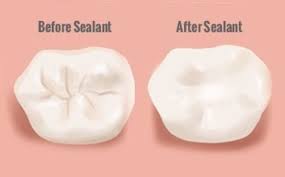Dental Sealants
Sealants are a protective varnish that is placed to protect the deep grooves in your back teeth. These grooves are “hiding places” that allow bacteria to accumulate and cause tooth decay. The sealant eliminates the “hiding place.”
We encourage all adults and children to have all of your back teeth properly sealed. Sealants can prevent the kind of decay that starts in the deep grooves of back teeth, and we believe if you keep your teeth properly sealed, you will eliminate your risk for this kind of tooth decay.
Dental sealants are thin coatings that when painted on the chewing surfaces of the back teeth (molars) can prevent cavities (tooth decay) for many years. Sealants protect the chewing surfaces from cavities by covering them with a protective shield that blocks out germs and food.
The CDC report states that dental sealants prevent 80 percent of cavities for two years after application. They also continue to protect against 50 percent of cavities for up to four years.
Are sealants covered by dental insurance?Are sealants covered by insurance? Some plans do cover dental sealants for children, teens and adults. Some only cover certain teeth. Check your benefits summary to see if they are included in your plan.
At what age are dental sealants most effective?About 7 million low-income children need sealants.
- Sealants are thin coatings painted on teeth to protect them from cavities. …
- Sealants prevent the most cavities when applied soon after permanent molars come into the mouth (around age 6 for 1st molars and age 12 for 2nd molars).
Do adults need dental sealants?Sealants are most often placed in children and teenagers, since tooth decay can start soon after teeth come in. But adults can sometimes benefit from sealants too, because you never outgrow the risk for developing cavities. A sealant can be placed on a tooth that does not have a cavity in its pits and grooves.
Why are dental sealants bad?Sealants have a shelf-life of five to 10 years, but it is imperative to have them checked at each dental check-up visit to be sure they have not chipped or worn over time. The slightest chip or break can lead to leakage and trap food and bacteria underneath, which can cause decay.

Do sealants damage teeth?They are not durable – in 5 years or less, you have to replace them. They can seal in dental decay – if your teeth are not properly examined, sealants can seal in acids in a decayed tooth, resulting in more harm than good. They cannot be applied over dental fillings or decayed teeth.
Can you chew gum with sealants?Buscemi utilizes the application of dental sealants on the appropriate teeth to prevent tooth decay and buildup of unwanted bacteria causing debris. The care of sealants is very important to ensure their efficacy. Frequently chewing gum or hard ice will risk pulling off or fracturing sealants.
Should I put sealants on my child teeth? Typically, children should get sealants on their permanent molars and premolars as soon as these teeth come in. In this way, the sealants can protect the teeth through the cavity-prone years of ages 6 to 14.
Can dental sealants be removed?After getting the dental sealants, patients can expect them to last up to 10 years with adequate oral care. They will not need to be removed; instead, the sealants will deteriorate with time until the dentist determines that they need to be replaced.
How long do sealants last on teeth?Sealants protect the chewing surfaces from cavities by covering them with a protective shield that blocks out germs and food. Once applied, sealants protect against 80% of cavities for 2 years and continue to protect against 50% of cavities for up to 4 years.
